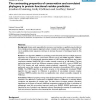159 search results - page 17 / 32 » Comparing approaches to predict transmembrane domains in pro... |
BMCBI
2008
13 years 8 months ago
2008
Background: Protein secondary structure prediction method based on probabilistic models such as hidden Markov model (HMM) appeals to many because it provides meaningful informatio...
BMCBI
2006
13 years 8 months ago
2006
Background: Proteins that are similar in sequence or structure may perform different functions in nature. In such cases, function cannot be inferred from sequence or structural si...
BMCBI
2006
13 years 8 months ago
2006
Background: Accurate small molecule binding site information for a protein can facilitate studies in drug docking, drug discovery and function prediction, but small molecule bindi...
BMCBI
2008
13 years 8 months ago
2008
Background: Amino acids responsible for structure, core function or specificity may be inferred from multiple protein sequence alignments where a limited set of residue types are ...
EVOW
2006
Springer
13 years 11 months ago
2006
Springer
Infection by the human papillomavirus (HPV) is associated with the development of cervical cancer. HPV can be classified to highand low-risk type according to its malignant potenti...

